When boredom began to peak during the third week of quarantine I managed to arrange a private gallery visit – including a meeting with the artist – to make up for what I had missed when there had been too much art to see.
Hassan Kamel’s sculpture exhibition “Daughter of the Sun” opened on 29 February at the ZagPick Gallery in Sheikh Zayed but was suspended a week later when the shut-down began. I was fascinated to enter through a gate adorned with two enormous resin Maat (or Justice) feathers (dated 2008-2020), which evoked a sacred space.
Facing me was the main piece in the collection, Daughter of the Sun, a sculpture assemblage featuring a life-size, elegantly shaped young woman in bronze and an installation of a rectangular basin in wood, plexiglass, fabric and gold plate – a sacred lake – flanked by mini sculptures of lotus flowers and feathers. The Daughter’s face can be seen reflected on the surface of the basin, and a positive sense of serenity emanates from the whole.
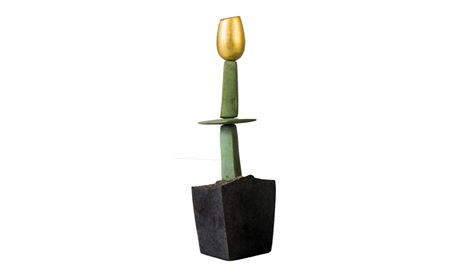
Seeding

Salutation
A professor of sculpture at the Faculty of Art Education, Helwan University, Kamel’s fascination with ancient Egypt began while he was studying for his masters degree, which dealt with clothing in sculpture in ancient Egyptian, Roman and Chinese art.
“Starting then ancient Egyptian arts became my main source of inspiration. I settled down in this holy land. The concept of art adopted by ancient Egyptian artists is different, characterised by a broad vision, and daily dialogue with nature covering all aspects of life.”
It was a civilisation pervaded by sculpture. Unlike Mahmoud Mokhtar, the father of modern Egyptian sculpture, who sought the connection between ancient Egyptian and European art, after studying the dimensions and aesthetic principles of specific sculptures through his PhD, Kamel developed his own concept of Abstract Value, which is different from a symbol in that – rather than referring to it – it embodies its core aesthetic value. In his own work, rather than imitating ancient art, Kamel reproduces this idea in his own idiom.
“The problem with ancient Egypt is that people think it’s a dead civilisation, that we’re already separate from our ancestors. I believe we remain connected with them. After years of sketching, studying and fieldwork on ancient sites, I could see how closely connected to life and nature art is.”

Human Boat
Born in 1967, Kamel was also inspired by such pioneering sculptors as Mahmoud Mokhtar, Abdel Badie Abdel Hay and Adam Henein. But the ancient masters remain his most effective teachers, and to this day he is finds inspiration in Sakkara, one of the earliest construction sites in the world, Luxor and the Egyptian Museum.
He also feels affinities with ancient Japanese and Mexican art and architecture and to such Europeans as Henry Moore, who in turn was influenced by ancient Egyptian sculpture at the British Museum.
Though this is his 10th solo exhibition, Kamel’s present philosophy began to form only eight years ago with his Cache exhibition series. “I realized some eight years ago that the sculptors mission is not to make a perfect statue. It is rather the project, the overall philosophy, the umbrella under which different and even unrelated sculptures denote one message.” This is very clear in the present collection, where the exhibits vary widely from a head with one arm raised (The Salute) to a marble house (Secrets). In the third installment of Cache, Kamel said what he meant by that was a treasure the artist would keep uncovering over his career.
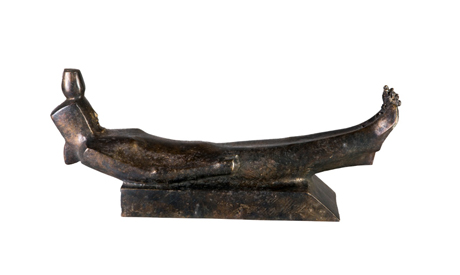
Sailor
The first Cache exhibition, “Season”, which was held at the Nile Gallery in 2016, focused on the lotus flower, symbol of the sun and of regeneration, which also took on the significance of the January Revolution.
The second, at Al Bab Gallery in 2017, was a miscellany of pieces from different times in their own unique dialogue and for which he designed his own layout for the space, creating paths with low ceilings. The same collection was held again at the Egyptian Museum in 2018 – the first of its kind.
“My work,” Kamel explained, “is influenced by the idea of God’s manifestation.
The ancients did not create idols to be worshipped in themselves, but containers for the divine presence. The secret of these sculptors’ genius is their spiritual connection to nature. They would meditate for hours in the open, contemplating eternity.”
The idea is far from limiting. “Ancient Egyptian art and philosophy covers all aspects of life. I can find a reference for every new idea that crosses my mind.” Roman sculpture might appear more lifelike and dynamic, though.
“But I believe ancient Egyptian sculptures reflected all schools of art: abstraction, realism, even surrealism. There are so many different things within it. Its diversity in itself is an inspiration.”
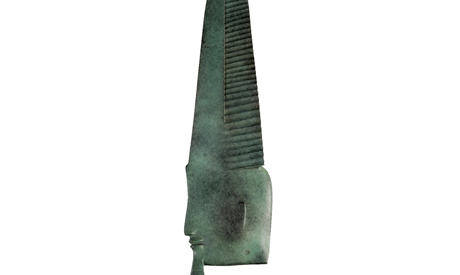
Feathered head
Concepts such as justice and light take on new form in the present exhibition. Kamel imagined that the sun had a daughter with a moon on her belly, and he decided to place her next to a body of water representing the eternal ocean that is the source of all living things.
The three pieces he made in 1998 were developed some 20 years later. And here as elsewhere Kamel skillfully handles a range of media: bronze, ceramic, granite, resin, and marble. This variety makes for a unique experience. Soliloquy, for example, is a medium-sized piece featuring a bronze figure absorbed in a monologue. Standing on a base of light green lotus flowers, this pivotal piece took 12 years to complete.
The Sailor, another bronze piece, features a head and two outstretched arms suggesting the shape of a boat and a desire for purity. Human Boat is a more explicit take on the same theme. Secrets, on the other hand, in Carrara marble, is a serene temple with two tiny gates ready for the resurrected dead to pass through. Two abstract heads with feathers recall the Amarna period statues of Queen Tiye, while Winged Entity is a headless bird that circles back to Soliloquy, suggesting a flight out of the physical body.
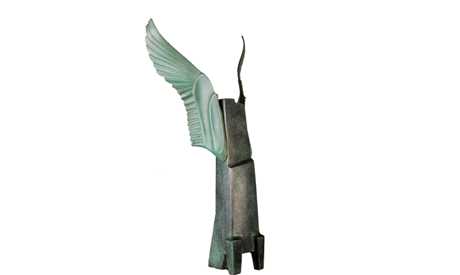
Winged Entity
Kamel is currently working on a book on his philosophy of sculpture and its connection with ancient Egyptian art. His sculptures’ distinctive blend of abstract expressionism and symbolism reflect the erudition as originality, and encourage you to read up on ancient Egypt. Perhaps the quarantine is an opportunity to end our isolation from our ancestors.
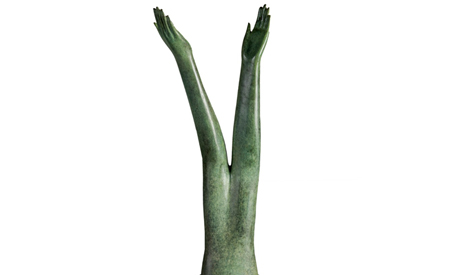
Pray
The exhibition can be viewed by private appointment
*A version of this article appears in print in the 16 April, 2020 edition of Al-Ahram Weekly
Short link: